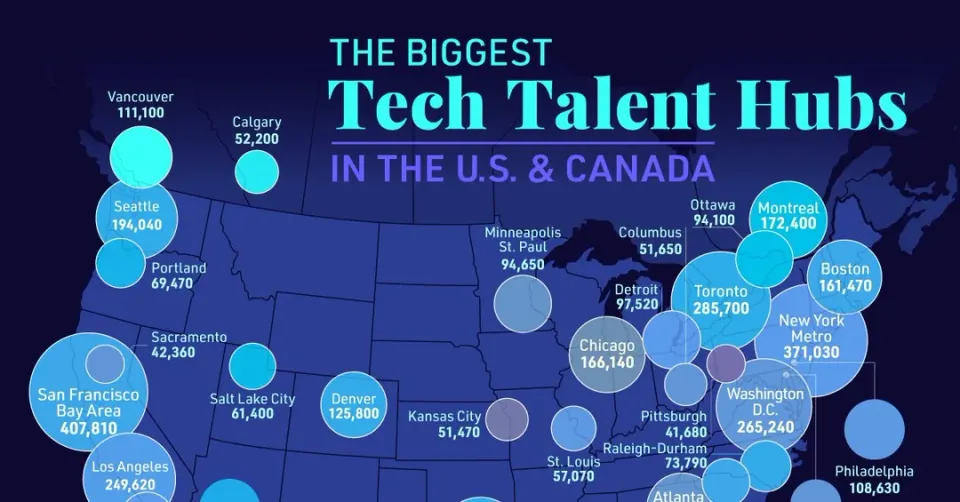US Tech Drain: How is Canada gaining?

A tech emploi cohort that can make a noticeable difference in the wider job landscape through the application of demanding innovations is currently determined by Canada’s timely interventions. Apart from concentrating on globally accepted best practices such as lean product development, agile methodologies, and customer development, Canada is gradually giving tech talent from America a way of staying in the country. Permit me to come up with a detailed explanation of the different reasons why Canada is getting tech workers, while the U.S. is having so much trouble doing that:
1. Canadian Immigration Programs that Target Specific Workers
Canada has strategically targeted groups at risk of rapid layoffs, like H-1B visa holders from the US in particular, following a proactive course of foreign talent acquisition. The government of Canada has set in motion a vast program for its experimental phase that was expected to last 30 June 2023 at the earliest with the completion of the appointment of at least 10,000 candidates, the majority of whom are H-1B visa holders from the U.S. This initiative particularly focuses on technology experts and deportees among those laid-off in the U.S. who do not have a job for the next three months according to the rigid time frame for finding new employment provided by U.S. immigration law.
The gathering of foreign persons such as students, researchers, and professionals on the Canadian campus who would otherwise be facing deportation from the U.S. gives this program immense significance from the perspective of the academic community. Canada’s more flexible visa laws are another attractive option for those who opt to change their career paths as it both provides them with job security and a route to permanent residency.
2. Talent Shortage in Emerging Sectors of the Canadian Technology Economy
With cities like Toronto, Vancouver, and Montreal at the forefront of this growth, Canada is on its way to becoming a major player in the global tech ecosystem. In particular, the cities are centers for innovation, with sectors such as artificial intelligence, cybersecurity, fintech, and cloud computing experiencing rapid growth. In such circumstances where the demand for highly skilled personnel in those industries is much higher than the supply of local talents, companies have had to look for foreign labor to carry out crucial tasks.
Canadian firms are taking advantage of the increase of American tech workers and providing salaries that are market-equal and thus a decent standard of living can be comprehended. The tech industry of Canada, in comparison to other U.S. big cities like Silicon Valley, Seattle, or New York has the advantage of lower living costs for employees.
3. U.S. Layoffs: A Tipping Point for Talent Migration
The technology industry in the U.S. has undergone a series of layoffs that are anticipated to move forward in 2024 and began back in 2023 due to budget cutting, mergers, and the focus of companies being on AI and automation. Big companies like Google, Meta, and Amazon were some of the major players to reduce their workforces and these companies let go of tens of thousands of employees. As per Layoffs.fyi, the tech sector layoffs in 2024 have surpassed in numbers those of 2023 with more than 42,000 employees being affected in the first quarter of this year, and this is unprecedented.
The story is quite harrowing for those workers like H-1B visa holders who have been laid off. These individuals, the H-1B visa holders, are given six days to find another place in the U.S. and, if that doesn't happen, they will be forced to leave the States. A lot of them have decided to choose Canada as a destination instead, since the conditions and policies are easier and the job market is growing there.
4. H-1B Visa Challenges: A Major Catalyst for Talent Loss
Although the H-1B visa program in the U.S. plays an indisputable role in bringing in foreign talent, it has increasingly been a source of frustration for employees and employers. The annual limitation on H-1B visas is a major reason for many talented applicants to be denied the job and the long waiting periods for obtaining permanent residency (green cards) create anxiety among employees. The 60-day reemployment time period after a layoff is usually too short for many H-1B holders, especially in an unpredictable labor market.
On the other hand, Canada provides a far more elementary and safe immigration process. Moreover, Canada has made further advancements in the Global Talent Stream program which is aimed at H-1B holders that make it easier for technical professionals to obtain work visas. The process takes only several weeks, in stark contrast to the months, and even years, it takes in America, and also, many of these visas come with permanent residency opportunity which is the attraction of tech workers who are looking for stability.
5. Better Work-Life Balance and Quality of Life in Canada
Compared with several US tech hubs, Canada offers a far better standard of living. Toronto, for example, for its affordable health care, a strong social safety net, and a multicultural environment, is consistently a part of the top cities in the world for a quality of life. On the contrary, tech workers in the United States often wrestle with the fear of high living costs, high-priced medical services, and the possibility of being out of work, especially in Silicon Valley and Manhattan, eclipsing the attraction of stable jobs.
Major cities in Canada provide a more robust lifestyle with shorter commutes' lower crime rates, and sustainability are of the essence. The lure of a dual career and a better life is particularly strong for multiply-skilled workers targeting families.
6. Canada’s Supportive Tech Policies and Ecosystem
Government support for the tech industry with diverse initiatives followed by the government of Canada has been very encouraging. A flourishing startup scene is created through tax incentives for research and development (R&D), government grants, and innovation hubs such as MaRS in Toronto. Canada is also an international center for AI research and development, and Google has actively funded the development of AI through laboratories such as DeepMind and the Vector Institute to its great advantage.
Meanwhile, Canadian universities are steadily feeding the tech talent pool, while the demand still outstrips supply, which is where the U.S. labor comes into play. The government policy aimed at attracting foreign workers is perfectly in-sync with the tech industry’s objectives securing a steady inflow of highly-skilled workers.
7. The Impact on U.S. Tech Competitiveness
The migration of U.S. talent to Canada has significant implications for the U.S. tech industry. A large number of the professionals who leave the U.S. are extremely adept in software engineering, AI, and machine learning, the areas that will determine the future of technology. The transfer of those skills to Canada could lead to a shortage of talent in new tech industries in the U.S.
Canada’s winning formula of facilitating U.S. involuntary discharge and visa problems thereby creating a techno-job environment is the game enhancer for its tech market. Should this innovation be left unchecked, Canada could not only fortify its power as a tech leader but also begin engaging more and more multinational corporations to open shops up north.
Conclusion
With the U.S. tech sector's job losses and restrictive immigration laws, Canada is a more appealing option for tech workers facing job displacement. Among all the things Canada offers, immigration benefits, a highly-expanding tech sector, and good living standards are very important reasons for being chosen by many skilled H-1B visa holders and other highly-skilled IT professionals as a refuge. This shift is not simply a reaction to one-off layoffs but rather it is a consequence of global migration tendencies which will transform the North American tech scene for a longer time period, if not forever.




